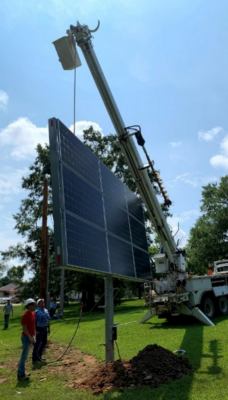As with most inventions, necessity drove James McKinion’s design for the Helical Solar dual axis, bifacial solar panel array. In 2016, McKinion wanted to maximize the area above cut pine trees for solar energy. However, it soon became apparent that the cost of bulldozing and clearing tree stumps was cost-prohibitive. He decided to engineer a solution.

He developed and patented a solar array design and received of several Small Business Innovation Research (SBIR) grants to develop a rural solar solution that could be used with agriculture while lowing electrical cost. The design included a 13-foot solar panel mount height that allowed for cattle grazing, tall crops, and mid-sized tractors. It also ensured landowners would not lose arable land. The panels rotate to follow the sun, so the shade from the panels does not require shade-tolerant crops. All cables run several feet underground, to ensure protection from animals and comply with code, and all cables above ground are encased in array. The access box consists of a heavy steel case designed to withstand an accidental tractor collision.
McKinion also faced the complexity of anchoring solar panels with a 10- foot screw pile. The cost of an excavator with a boom tall enough to auger the anchor piles far exceeds the energy savings. To address this, he experimented with work-trucks commonly used by municipalities and rural electrical cooperatives, known as Digger Derrick trucks. He then found further cost savings when he decided to ship pre-assembled solar panels and parts to electric utility companies and train them perform the installation with existing equipment and staff.
The design also addressed another rural co-op problem: the lack of reliability among solar installation companies. For example, the Utility Board in Arkansas did not want to recommend solar installers to their constituents because many were not available for troubleshooting and support after installation. Helical’s solution allowed the utility companies to install the system while also providing an interface that would give customers real-time information about the energy being produced.
Helical now has prototypes operating in five states, with plans to update older panels. Currently, they are nine 360-watt bifacial panels in the system equaling 3.24kW. McKinnon estimates that the bifacial panels produce 10% more energy than a rooftop system and that dual-axis tracking produces an additional 35% energy production. The newer panels will be 550-watt series panels for a 4.95kW system. With the total 45% gain from the dual-axis, bifacial set-up, McKinion predicts an output that would typically be seen from a 7.6 kW system. These systems are engineered to offset the energy consumption of a typical single-family home.
